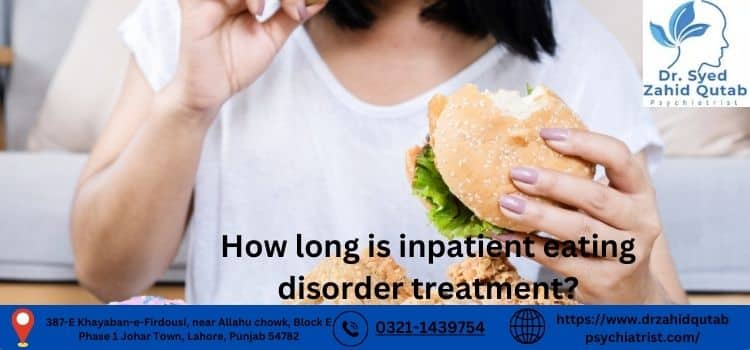The duration of inpatient eating disorder treatment can vary significantly based on individual needs and the severity of the disorder. The question arises how long is inpatient eating disorder treatment Typically, patients might stay in an inpatient facility for several weeks to several months. The initial phase often focuses on medical stabilization and nutritional rehabilitation. Following this, the treatment might extend to address underlying psychological issues and develop coping mechanisms.
In this blog, we will explore the different stages of inpatient eating disorder treatment in more detail. Firstly, the assessment phase is crucial for developing a tailored treatment plan.
Let’s dive in to get more details.
How long is inpatient eating disorder treatment?

The duration of treatment depends upon the severity of disorder. Some of the Outline of Stages in Inpatient Eating Disorder Treatment are given below:
Medical Stabilization and Nutritional Rehabilitation
The initial stage of inpatient treatment focuses on stabilizing the patient’s physical health. This involves managing any immediate medical issues, reintroducing nutrition in a balanced way, and monitoring vital signs to ensure safety.
Assessment Phase
A comprehensive assessment is conducted to understand the patient’s medical history, psychological background, and specific needs. This phase is essential in crafting a personalized treatment plan.
Psychological Therapy and Counseling
Once the patient is medically stable, psychological therapy becomes the mainstay of treatment. Different therapeutic approaches, such as Cognitive Behavioral Therapy (CBT), Dialectical Behavior Therapy (DBT), and family therapy, are employed to address underlying emotional and psychological issues.
Development of Coping Mechanisms and Life Skills
Patients are taught various coping strategies and life skills to help them manage their eating disorder in the long term. This includes stress management techniques, healthy food, and ways to handle triggers.
Preparation for Transition to Outpatient Care
As the patient progresses, preparations for transitioning from inpatient to outpatient care begin. This includes developing a support system, creating a follow-up care plan, and ensuring the patient has access to the necessary resources and services.
Challenges and Barriers to Inpatient Eating Disorder Treatment
Outlined below are key challenges and barriers often encountered during inpatient treatment for eating disorders:
Resistance to Treatment
Patients may exhibit resistance to treatment, stemming from fear, denial, or a strong attachment to their disordered eating behaviors.
Managing Co-occurring Disorders
Many individuals with eating disorders also struggle with co-occurring mental health issues, such as depression, anxiety, or substance abuse, which complicates treatment.
Cost and Accessibility
Inpatient treatment can be expensive and not readily accessible to everyone, posing financial and logistical challenges for many families.
Relapse Prevention
Relapse is a common concern, and ensuring long-term recovery requires ongoing support and vigilant relapse prevention strategies.
Family Involvement
Family dynamics can play a significant role in the patient’s recovery process, and involving family members in therapy and education is often crucial but can also present challenges.
Success Factors in Inpatient Eating Disorder Treatment
Certain factors can enhance the likelihood of a successful inpatient treatment outcome:
Personalized Treatment Plans
Tailoring treatment plans to address the unique needs of each patient can significantly improve treatment outcomes.
Comprehensive Approach
A holistic approach that includes medical, nutritional, psychological, and social support offers the best chance for recovery.
Experienced Multidisciplinary Team
A team of experienced professionals, including doctors, therapists, dietitians, and social workers, can provide well-rounded care.
Continued Support Post-Discharge
Consistent follow-up care and support after discharge are essential to help maintain progress and prevent relapse.
Techniques and Therapies Used in Inpatient Eating Disorder Treatment
Techniques and Therapies Used in Inpatient Eating Disorder Treatment are given below:
Cognitive Behavioral Therapy (CBT)
CBT is a structured, time-limited therapy that focuses on identifying and changing negative thought patterns and behaviors. It is widely used in the treatment of eating disorders to help patients develop healthier ways of thinking and behaving around food and body image.
Dialectical Behavior Therapy (DBT)
DBT combines cognitive-behavioral techniques with mindfulness practices. It helps patients manage their emotions, improve relationships, and reduce harmful behaviors.
Family-Based Therapy (FBT)
Also known as the Maudsley Approach, FBT involves the family in the treatment process, empowering them to support their loved one’s recovery. It is particularly effective for adolescents with eating disorders.
Nutritional Counseling
Nutritional counseling helps patients understand the importance of balanced nutrition and develop healthy eating habits. Dietitians work closely with patients to create individualized meal plans that meet their nutritional needs.
Importance of Aftercare and Support Programs
Aftercare and support programs are vital for maintaining recovery after discharge from inpatient treatment. These services provide continuous support, helping individuals navigate the challenges of daily life while maintaining progress in their recovery journey.
Outpatient Therapy
Ongoing therapy sessions can help individuals continue to address underlying psychological issues and reinforce the skills learned during inpatient treatment.
Support Groups
Peer support groups offer a sense of community and shared understanding, providing encouragement and solidarity during the recovery process.
Nutritional Follow-Up
Continued nutritional counseling ensures that patients remain on track with their recovery goals and maintain a healthy relationship with food.
Relapse Prevention Strategies
Implementing strategies to identify and manage triggers, reinforcing coping mechanisms, and developing a robust support network are critical components of relapse prevention.
Emerging Trends in Eating Disorder Treatment
The field of eating disorder treatment is continually evolving, with new research and innovative practices enhancing the efficacy of care. Some emerging trends include:
Telehealth Services
Telehealth has become a pivotal component in the continuity of care for eating disorder patients. Utilising virtual platforms for therapy sessions, nutritional counselling, and support groups offers flexibility and accessibility, ensuring that individuals can receive treatment regardless of their geographical location.
Integrative Therapies
There is a growing emphasis on integrative therapies that combine traditional treatments with alternative approaches. Practices such as yoga, art therapy, and mindfulness meditation are being incorporated into treatment plans to address the holistic needs of patients, promoting both physical and emotional healing.
Genetic and Biological Research
Advancements in genetic and biological research are providing deeper insights into the underlying causes of eating disorders. Understanding the genetic predispositions and neurobiological factors can lead to more targeted and effective treatment strategies.
Inclusive and Diverse Care
Recognizing the diverse experiences and backgrounds of individuals with eating disorders, there is a shift towards more inclusive care practices. This includes culturally sensitive treatment approaches and specialized programs for underrepresented groups such as males, LGBTQ+ individuals, and people of different racial and ethnic backgrounds.
Enhanced Family Support Programs
Family support is increasingly viewed as a critical aspect of recovery. Enhanced family-based programs that offer comprehensive education, counseling, and involvement in the treatment process are proving to be effective in fostering a supportive home environment for the patient.
By staying abreast of these emerging trends, treatment facilities can continue to improve their approaches, offering patients the best possible chance for recovery and a healthier future.
Conclusion
The question asked by people is how long is inpatient eating disorder treatment eating disorder treatment is a comprehensive approach designed to address the multifaceted nature of eating disorders. By integrating medical, psychological, and social support, treatment facilities aim to support individuals on their path to recovery and equip them with the tools needed for long-term success.
FAQs
Frequently asked questions by people:
What is the recovery rate for eating disorders?
The recovery rate for eating disorders varies depending on the type of disorder, the duration of the illness, and the treatment methods used. Research indicates that around 50% of individuals with an eating disorder will fully recover, 30% will show significant improvement, and the remaining 20% will continue to struggle with the disorder.
What percentage of eating disorders go untreated?
Approximately 70% of individuals with eating disorders do not receive treatment. This alarming statistic highlights the need for increased awareness, better access to care, and reducing the stigma associated with seeking help for eating disorders.
